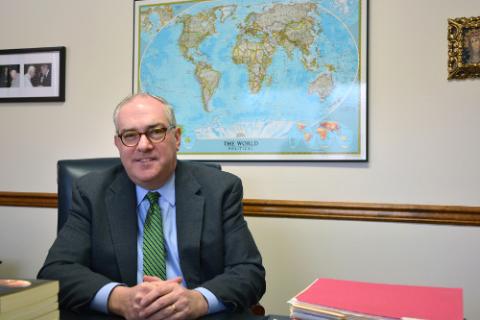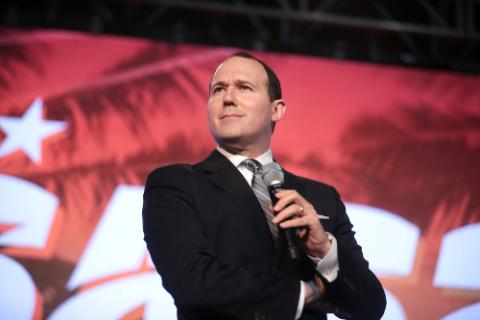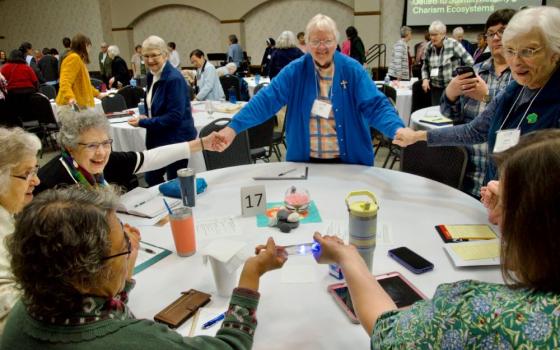
The control room of EWTN in Irondale, Alabama, on Jan. 8. (RNS photo/Jack Jenkins)
When Archbishop Carlo Maria Viganò wants to get the attention of the pope or his fellow bishops, he sits downs and writes a letter.
Then he sends it to Alabama.
At least that's been the pattern since last summer, when Viganò made headlines worldwide after he called on Pope Francis to resign for allegedly covering up misconduct and abuse by Theodore McCarrick, the former archbishop of Washington, D.C. and a former member of the College of Cardinals. It was the first in a series of letters published by the National Catholic Register, a conservative Catholic publication whose parent company is based near Birmingham.
Viganò's latest letter, published Jan. 14 by the Register, calls on McCarrick to repent.
"Time is running out, but you can confess and repent of your sins, crimes and sacrileges, and do so publicly, since they have themselves become public," wrote Viganò. "Your eternal salvation is at stake."
Analysts argue Vigano's controversial letters — and the international media firestorm they sparked — are a sign of the Register's growing influence alongside its parent organization, the Eternal Word Television Network, which also owns the Catholic News Agency. EWTN leaders have spent the better part of four decades quietly building a Catholic media empire that spans the globe.
But the conglomerate, which was founded by a nun, has also drawn waves of scrutiny from cardinals and commentators who argue EWTN uses its profound resources to shore up conservative political and theological positions and attack Pope Francis.
Not that you would know any of this if you pulled up to EWTN's headquarters in Irondale, Ala.
The unassuming brick buildings that house the organization are tucked away in the small Bible Belt suburb outside Birmingham, where pale, weather-beaten statues of biblical figures dot EWTN's grounds. The facilities include EWTN's own in-house sanctuary, where masses are televised and broadcast worldwide every day. The Monastery of the Poor Clare Nuns of Perpetual Adoration and the Shrine of the Most Blessed Sacrament are just a short jaunt away.
EWTN was founded in 1980 by Mother Angelica, an American Poor Clare nun who was inspired to create her own Catholic television network after visiting a Baptist television station in Chicago, according to a timeline of her life posted on EWTN's website. Staffers say she also got a helping hand from televangelist Jim Bakker, who sent workers to Alabama to help build EWTN's first studio.

EWTN Chairman and CEO Michael Warsaw in Irondale, Alabama, on Jan. 8. (RNS photo/Jack Jenkins)
Staffers are quick to recount the story of how she had only $200 in her pocket when she ordered her first $600,000 satellite dish (a communications staffer said a funder miraculously appeared the day it arrived), or how she would go on to become an international sensation after she began broadcasting her own show.
EWTN staffers say the nun — whose arrival in Alabama triggered attacks and attempted shootings from the anti-Catholic Ku Klux Klan — drew on her faith to dispel any fear of failure.
"One of the things that I learned from (Mother Angelica) was that if you remain faithful and if we execute our mission faithfully and trust in God and God's providence, then he will provide and you don't need to be afraid," EWTN Chairman and CEO Michael Warsaw, whose window overlooks the network's six white satellite dishes, told Religion News Service.
Warsaw, who joined the network in 1991 and knew Mother Angelica closely until she passed away in 2016, pointed to a ceramic sign on his desk as he spoke, noting he inherited it from Mother Angelica herself: "Be not afraid."
EWTN staffers said reruns of Mother Angelica's broadcasts are still popular, as are the network's slate of faith-themed documentaries, talk shows and streams of Vatican events. As employees walked RNS through the compound's labyrinth of studios and offices, footage of Mother Angelica could still be seen among the array of screens flickering in the station's various control rooms.
In recent years, however, EWTN has expanded beyond primarily faith-focused lineup and into the news space, hiring television reporters and building studios in places like Washington, D.C. The network now claims one of the coveted stand-up tents next to the White House lawn for live television shots, standing alongside CNN, MSNBC and Fox News. It also acquired other Catholic news outlets, purchasing the National Catholic Register in 2011 and the Catholic News Agency in 2015.
The organization's reach dwarfs that of almost every other faith-based media company in the United States, rivaling the evangelical Christian Broadcasting Network. Staffers say EWTN alone runs at least 11 around-the-clock networks that are available in 310 million television households across 145 countries, not to mention a sizable radio audience.
Advertisement
Meanwhile, the combined website views for the Register and CNA top out at around 40 million a year.
Their size has proven powerful: Warsaw credited EWTN's coverage of the March for Life, a massive annual anti-abortion gathering, with helping to raise its profile both in the U.S. and abroad.
Thomas Tweed, director of the Ansari Institute of Global Engagement with Religion at the University of Notre Dame, said the expansion of conservative Catholic media coincides with spikes in polarization.
"I think the same thing that has happened in American political life and media has happened to some extent to Catholics," he said. "Progressive Catholics read Commonweal and the National Catholic Reporter, and traditionalist Catholics watch EWTN and read newsletters from the Blue Army."

Raymond Arroyo speaks at the 2018 Student Action Summit hosted by Turning Point USA at the Palm Beach County Convention Center in West Palm Beach, Florida, on Dec. 21, 2018. (Gage Skidmore/Creative Commons)
As EWTN's journalistic voice grew louder, so too did its critics, particularly National Catholic Reporter columnist Michael Sean Winters. He has repeatedly accused EWTN of being conservative to the point of partisanship. He's been especially critical of Raymond Arroyo's EWTN show "The World Over" for, among other things, inviting guests who defended Trump's proposed border wall — despite Pope Francis' public rebuke of the idea (and Trump's faith) in 2016.
In an interview with RNS, Winters argued Arroyo's show in particular is beginning to resemble Fox News. He noted Arroyo identifies as a Fox News contributor in his Twitter biography and guest-hostedLaura Ingraham's Fox News show on Jan. 4. The host also tweeted that he was part of an elite group of television anchors invited to lunch with President Trump hours before a national address.
"If you're a Catholic ministry and you have Raymond Arroyo on your programming, you are presenting a sectarian Catholicism that is unrecognizable as Catholic," he said.
Other critics of Arroyo include South African Cardinal Wilfrid Napier, who accused him of fueling anti-Francis sentiment in December, tweeting, "I've still to hear a programme (of Arroyo's show) that doesn't report negatively on or attack Pope Francis!" And in February 2018, papal adviser Antonio Spadaro reportedly retweeted a call to "interdict" EWTN, or impose a censure prohibiting individuals from participating in certain religious rites.
Arroyo did not reply to interview requests for this story.
Warsaw defended Arroyo's show, saying it has an "orthodox Catholic perspective" that "tries to follow the traditional teachings of the church on the broad spectrum of issues and doctrine." He speculated more people watch Pope Francis regularly on EWTN than anywhere else.
And when it comes to political issues, he said the Catholic Church allows for debate on many topics.
"You can be within the confines of the teaching of the church and have very different views as to how something like immigration policy should play out," said Warsaw.

An angel statue at the entrance to the EWTN studios in Irondale, Alabama, on Jan. 8. (RNS photo/Jack Jenkins)
The Register's handling of the Viganò letters has also raised questions.
Viganò reportedly "privately shared his plan to speak out" last year with EWTN board member Timothy Busch, according to the New York Times. The same report also stated that Busch, a wealthy Catholic donor, claimed EWTN's leadership was personally assured that Pope Benedict XVI had confirmed Viganò's account.
Busch has admitted that he spoke with Viganò before the letter was released but insists their conversations were not about "the contents" of the letter.
Warsaw echoed a similar position to RNS.
"No one from EWTN or any outlet with EWTN ever had any conversations with (Viganò) prior to that (and) never was involved in the drafting, conceptualizing or otherwise, of that letter," Warsaw said. "What was reported by the (New York) Times was not what was expressed to Tim Busch, nor was it what Pope Benedict said."
The New York Times did not immediately respond to inquiries about Warsaw's comments but told RNS in the past that it stands by its reporting on Viganò and Busch.
Warsaw said the decision to distribute the first Viganò letter — which he said was brought to the Register, where he is publisher, "based on longtime relationships" — was a purely journalistic one.
"Any journalist, regardless of what outlet they were at, was going to publish that letter," he said. Warsaw said he hasn't spoken to Viganò in "well over a year."
Overall, Warsaw said his core concern is not EWTN's size but whether its work reflects the brand of faith it claims.
"At the end of the day, the legacy of EWTN is not how big it is, not all the satellites or the affiliates or the stations," he said. "The legacy and the witness of EWTN to the world is how we've done what we've done, which is by relying completely and totally on God's providence.




